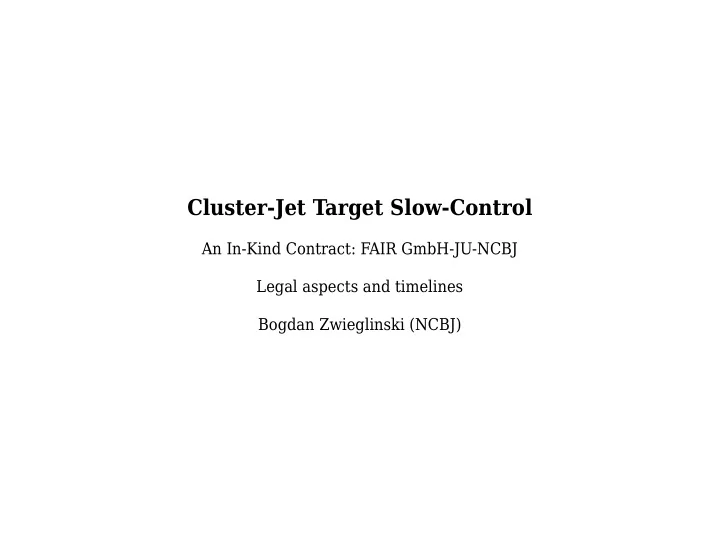

Cluster-Jet Target Slow-Control An In-Kind Contract: FAIR GmbH-JU-NCBJ Legal aspects and timelines Bogdan Zwieglinski (NCBJ)
The Shareholder (JU-Krakow) commissions the Provider (NCBJ Warsaw) with the following Contribution to the PANDA Detector: Development, Prototyping, Production, Delivery, Assembly and Testing of the Slow-Control System for the Cluster-Jet Target of the PANDA Detector as part of the Work Package PSP 1.4.1.2.4 for the PANDA experiment.
Main deliverables related with this Work Package: 1. An electronic system consisting of the elements defjned in Tables 3 and 3A of Annex3, installed in two racks (#1 and #2) to serve the cluster-jet source (generator) and the cluster-jet beam-dump, respectively. 2. A system of software programs either purchased by NCBJ or written by members of the team to ensure correct operation of the cluster-jet source and the cluster-jet beam-dump.
A defjnition of the correct operation of the cluster-jet source and the cluster-jet beam-dump should be considered in context of the four states of the Cluster-Jet Generator: * Shutdown, * Standby, * Tuning/Calibration, * Physics Run. The Slow-Control System should ensure smooth transitions between these states under the commands issued by the supervisory Detector Control System (DCS). In the stationary conditions of each of these states the operation of each target component will be monitored /controlled to prevent from any risk of damage to the PANDA Detector or the HESR accelerator.
An application of powerful control units is foreseen for this purpose. A close collaboration between the WWUM (home of the cluster-jet target) team and the NCBJ team is considered as a prerequisite of the project success. The Contract is planned to be executed in the time span of four years: 01.09.2016 - 31.08.2020, which probably will not yet see the cluster-jet generator installed on the top of the PANDA solenoid, while the beam-dump below the PANDA solenoid in the PANDA hall in Darmstadt. However an extensive program of tests mostly at FZ-Juelich is foreseen.
The project is foreseen to have the following major milestones: M4 (the tripartite Contract signed) T0 - 01.09.2016 (the bipartite Contract signed) T1=T0+1m Start of the funding fmow T1+1m Work on the System Prototype (2017) Programming a control of the fjeld layer (mostly in LabVIEW) M8 Hardware and programs ready for the Prototype implementation end of 2017 Work on the production version (2018) Programming a control from the supervisory level (mostly in EPICS) M9 The production version fully implemented end of 2018 Tests of the production version with protons at COSY (2019). Possibility of synergy with the Luminosity Detector M10/M11 end of 2019 Tests of the slow-control dynamics under varying cluster-jet densities. Tests in the PANDA/HESR vacuum environment (Q1-Q3 2020) M12 end of Q3 2020 Milestones fjtting the annual sequence - a request of the Funding Agency - the Ministry of Science and Higher Education of Poland
There is a request of the Provider's Administration to have each milestone accepted with a written protocol. A body qualifjed to perform this task will include: The Subsystem Coordinator, The PANDA Detector Control System (DCS) Coordinator, The PANDA Technical Coordinator, The PANDA Spokesperson (milestones M4 and M12).
Thank you for your attention.
Recommend
More recommend